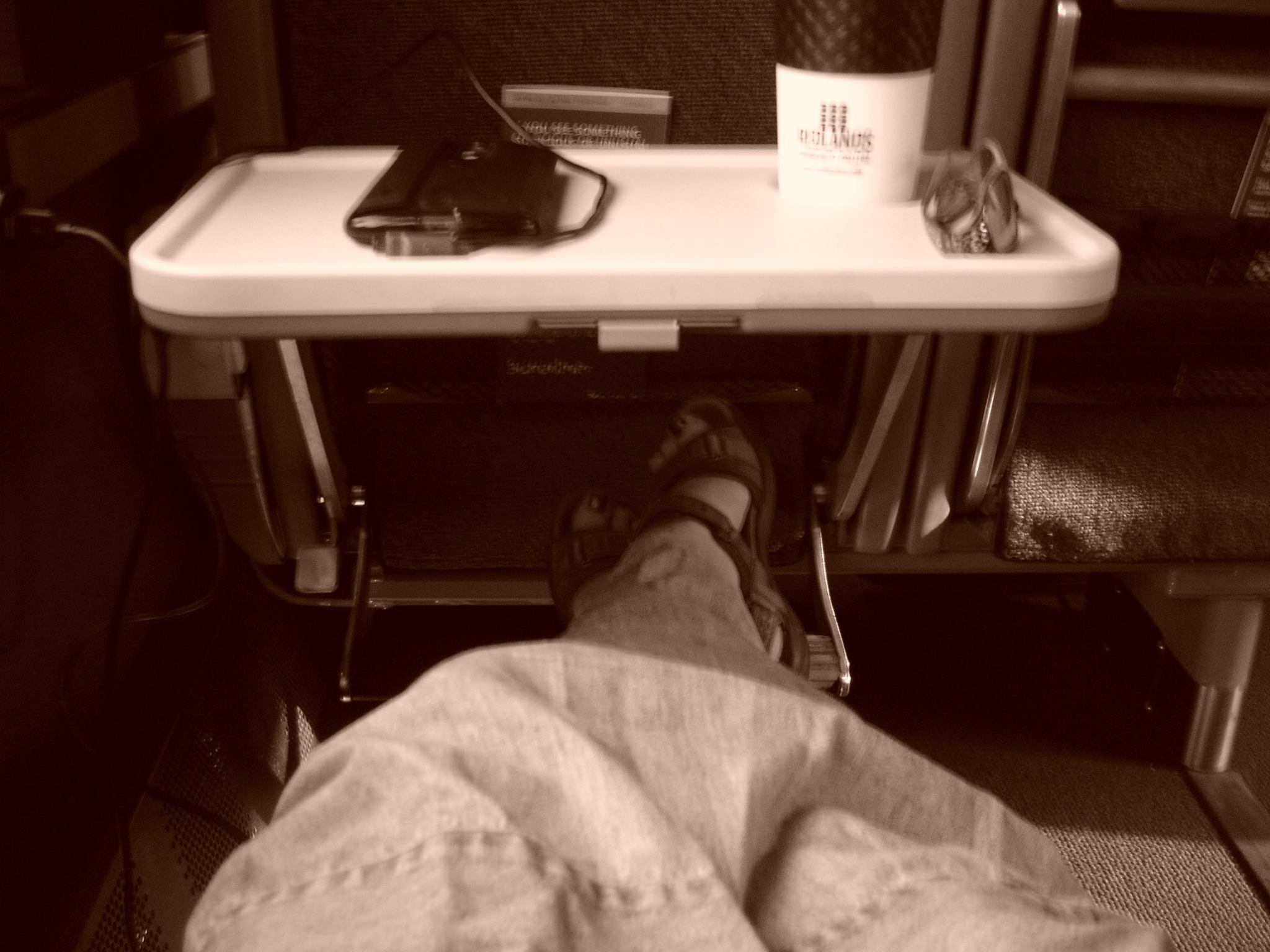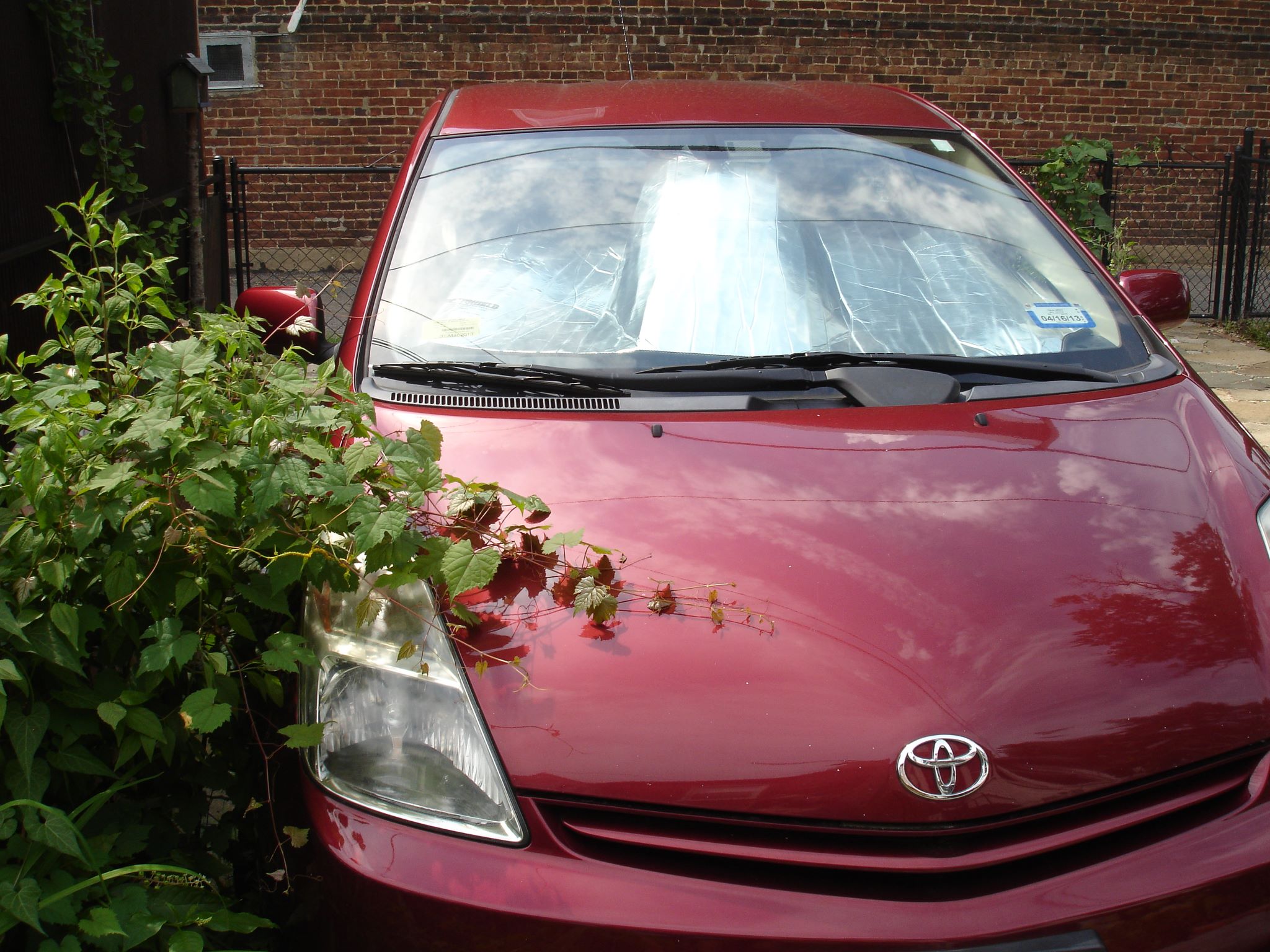Here I am flying on an airplane, in the dreaded, uncomfortable middle seat, elbows tucked in like crazy, even though they are on the armrests. There is not enough space for me to bend and put my laptop bag back under the seat in front of me, so my bag is leaning against my legs and cutting a line in my shins. For five hours, I will live in fear that the person in front will put their seat back and crack my computer monitor. Although it is my company’s computer (ha, ha) – I never risk mine when traveling.
Such is the joy of flying. Luckily on this trip, my seat mates are nice, as are the attendants, and the beauty of flying is that you don’t get constant email unless you pay to get email. Yet.
But this is my sixth trip since mid-August, and I have three more trips before year’s end. I get exhausted just thinking about it. My trips are all over the map: Texas (2), Delaware, West Virginia, Wyoming, Louisiana, Montana, and the MidEast (2). Texas is to visit my elderly parents – the remaining trips are for work, including two by car, a train trip (more below), and the rest flights. All told I have 22 flights in there – yowzer. Please note that these are great trips, and my organization is doing wonderful work and helping amazing people. However, besides the fact that all this travel is kicking my butt, it is also not exactly helping the planet and is generating tons of carbon dioxide (C02). Literally tons and tons.
25.3 tons (NativeEnergy calculator)
14.9 tons (My Climate calculator converted to the English ton)
19.6 tons (www.Carbonfund.org converted to the English ton)
What the hell? They don’t match. Well, different groups use different calculations (not all present their formulations), and some sites are less up-to-date than others. But for the purpose of this exercise, I am going with an average of 20 tons.
- Which means having my body being blasted off the earth, against gravity, and flown through the air 22 times, or sped down roads, has generated 20 tons of C02. (The vast majority is due to flying.)
- Which means that I have created/will create over twice as many C02 emissions on these 9 trips total than the annual C02 emissions per EU citizen (!), which is 10 tons (converted from the 9.1 tonnes on MyClimate website – and fyi, here’s a scary chart for us Americans).
- Although I think I probably produced less C02 than that average, as I was squished in the smallest damn seats on the plane, plus I weigh less than the typical American woman, which is 168 pounds, btw.
- And nevermind the C02 generated in these six months through washing clothes, cooking pizza, and driving to the doctors, things that are quite beyond what a typical ape (breathing C02) hanging out in the forest (absorbing C02) would generate.
Could I have avoided some of these trips and thus not generated this extra C02? I wish, but every one of these trips “required” in-person consultation and training of colleagues, which I couldn’t do through teleconferencing, and certainly helping my Dad through dental surgery was needed. Still, I am thinking I could have stepped away from one of the conferences possibly. I just can’t believe this fall turned into this many trips.
The thing is, I already took some steps to minimize climate change, so the number of tons is actually lower than it could have been. So how did I try to do this, and can I improve?
Carpooling
On the first of these work trips, a colleague and I carpooled to another state very close by. Unfortunately her rental car was a huge SUV, much bigger than she thought she was getting. I don’t want to calculate the tonnage on that. Darn, okay (0.025 tons, for my portion). Still, I am glad she thought of carpooling, and I will see if colleagues and I can’t carpool more.
Asking for a rental car with good fuel economy…
….but getting a Jeep Wrangler instead. This was in Delaware, and the tiny place I picked up my car at only had one car left, a mega Jeep Wrangler. Sigh. I didn’t even have a chance to take the top off for driving at the beach. Tons of C02 estimated generated: 0.12 tons. Car rental people shocked by a request to replace a Jeep Wrangler with a small, economic car? Two.
Driving my own car
I could have flown on the next trip, but chose to drive, as driving generates much less C02 than flying, apparently. (The NativeEnergy calculator shows .05 tons for driving from DC to Morgantown, West Virginia, whereas flying would have been 0.42 tons).

- I don’t drive that often.
Plus, the distance was such that driving time equaled the same time as flying, so I went for it – in my very fuel efficient 2005 bought-used Prius, with new tires, that got 60 mpg on those W. Virginia highways.
Yet – think of all the toxins generated by building those lovely tar roads. And I, as a solo person, still generated 0.05 tons of C02. I’m not sure the planet came out ahead on this one.
Taking the train:
I swore in one of my first blog posts (New Year’s Climate Resolutions), that I would replace a flight with a train trip this year. Done. Next week I will be taking the train from Washington, DC, all the way to Louisiana. A three-hour flight will be replaced with a 24-hour train ride. Overnight. Just as expensive as the flight. Crazy.
Yet, an adventure.  I have taken trains from DC to Chicago (RT) and from Oklahoma to Texas before https://adventuresacrosstheyears.wordpress.com/2016/12/20/train-to-texas-a-timescape/) – and they are fun, relaxing – and ROOMY. I sleep well on trains, and better yet, I write well on trains. I will be able to get up and walk around anytime I want. I will see part of the U.S. I have never seen before through big windows with my feet propped up in the recliner chair.
I have taken trains from DC to Chicago (RT) and from Oklahoma to Texas before https://adventuresacrosstheyears.wordpress.com/2016/12/20/train-to-texas-a-timescape/) – and they are fun, relaxing – and ROOMY. I sleep well on trains, and better yet, I write well on trains. I will be able to get up and walk around anytime I want. I will see part of the U.S. I have never seen before through big windows with my feet propped up in the recliner chair.  On my previous train travels, I also people-watched, an interesting past-time as a train is basically a moving community. But more on that on my next ‘la, la, la, I’m traveling” climate change blog, which will be written on the train to Louisiana while I have insomnia and can’t sleep because my seatmates are noisy. By the way, I am flying back.
On my previous train travels, I also people-watched, an interesting past-time as a train is basically a moving community. But more on that on my next ‘la, la, la, I’m traveling” climate change blog, which will be written on the train to Louisiana while I have insomnia and can’t sleep because my seatmates are noisy. By the way, I am flying back.
Carbon tons from ‘train-ing’ on the way: 0.02. Carbon tons flying back: 0.53.
Offsetting my carbon
Though trains are much, much better, no matter what I do, I generate C02 when I travel. But there is also this thing called “carbon offsetting,” that, when you can’t avoid traveling, you can use to calculate how much C02 you generated and then donate the equivalent cost of that C02 to a cause that helps save the planet – preferably a cause that prevents C02 output or that sequesters it. The organization I work for doesn’t do carbon offsets, unfortunately, but we are a nonprofit, fighting the good fight to help people understand what science is all about, including the science of climate change.
For my personal travel, though, I have been carbon offsetting occasionally since 2009, and will continue – as the LAST RESORT, when I can not avoid traveling. All carbon offsets I have paid so far have been through Native Energy, which I could have sworn when I first started focused on Native American solar and other projects. Now it seems to be a Vermont-based company with some Native American staff that is mostly about global projects. My only choice for my carbon offsets for a round trip to Texas ($28 for 1.59 tons) went to an Ethiopian clean water project, which, by providing water filtration, prevents people from having to use wood to boil water.
Here is a nice article by the Natural Resources Defense Council on what to consider when you buy carbon offsets: https://www.nrdc.org/stories/should-you-buy-carbon-offsets. Two key points include: 1) they should be third-party certified (all ones mentioned here are); and 2) the action should be permanent.
And here are some potential carbon calculators that also allow you to buy offsets.
- Native Energy, mentioned above, has not only travel calculators, but household and business calculators, as well as carbon-calculating software for businesses. The travel calculator lets you map multiple trips. However, their train calculation doesn’t seem to be working.
- The Nature Conservancy’s calculator – is based on your general carbon lifestyle, and you can’t calculate a trip. Also, the offset form is divorced from carbon calculator. But TNC is a good group.
- MyClimate calculates flight distances for you, but for cars, you have to calculate the distance, and oh, convert from liters and kilometers. They do have a number of C02 prevention and sequestration projects to choose from for compensation.
- CarbonFund.org has a simple calculation tool, which pre-calculates the “carbon cost” and connects directly to an offset tool. However, it does not include small regional airports. Their train tool also doesn’t work (somehow I doubt it is only 2.2 miles between Washington, DC, and New Orleans, roundtrip.) Also, the car calculator is for annual mileage, not trips.
- Others I am still looking into:
- https://www.carbonfootprint.com/calculator.aspx (calls itself the most popular…)
- https://www.terrapass.com/carbon-footprint-calculator
- https://www.epa.gov/energy/greenhouse-gas-equivalencies-calculator (based on energy units, not trips.)
So far, I think Native Energy is the best (has mapping tools) for those of us in the US, but we’ll see; it seems to be generating higher carbon numbers than the others, thus requiring more money for offsetting. It will be important to research their calculations.
Oh, we’re not done here yet….
Fighting climate change in airports and hotels…
What to do while waiting around in airports and hotels? Oh boy, do I have ideas, but this will be a separate post.
Finally, how about not traveling?
In the Facebook group Climate Steps that goes with this blog, we have been discussing traveling quite a bit, since it is one of the leading causes of C02 emissions (Wynes and Nicholas, 2071: http://iopscience.iop.org/article/10.1088/1748-9326/aa7541). One of my favorite graphs for illustrating their data is…(seeking permission to share the image itself….) from Phys.org: https://phys.org/news/2017-07-effective-individual-tackle-climate-discussed.html.
Amazingly, the only two Rogers in the our Climate Steps group have both made it part of their business ethics to minimize flying and instead hold teleconferences. I admire them greatly, and I hope to somehow start doing something similar. I have always been shy about teleconferences (I mean the lighting can suck and make you look older and more tired – or actually, rather, it shows your age and the level of exhaustion you currently have), but if set up correctly, it can be very well done. I encourage folks to try it more. And I am proud of my organization in that for one mega-program they now remote conference, where otherwise hundreds of people would have to fly. But for my job, it’ll be trickier. We’ll see what I can do.
And ta da! And that’s the blog post, so far. More ideas are welcome here or in the Facebook group. I’ll set up a Travel sub-page on this blog to pull the thoughts together when we get more.
Thanks!
Annette



You seem like a nice & cheery person. I don’t want to discourage you. But seriously: you need to stop flying & thinking you can somehow “buy your way out” or “offset” the damage you’re doing. A job that requires 22 flights per year is by definition an environmental disaster. Your parents or certainly your grandparents didn’t inject gallons per mile of jet fuel into the upper atmosphere even before Climate Change was an issue.
My wife & I took a once-in-a-lifetime trip to Czech Republic lastmonth and more than doubled our carbon footprint for the whole year. It was an unnecessary guilty act that outweighed the brief pleasure. Crunch some numbers: yours is an environmental horror story.
Whatever you’re doing, you are not The Indispensible One. Talking this up just leads other thoughtless folks to have their air travel & believe they’re environmentally responsible.
Walk, ride a bike, take mass transit, drive a zero emisson vehicle & respect its limitations. Work locally and by example to persuade those around you with your energetic personality.
Today more than ever there are so many better ways you can communicate over great distances than putting your body on an airplane. If your job requires it, your first climate change task is to talk with your employer.
I wish you well in your endeavor.
Seriously – I am already so discouraged. Writing about climate change in, well I wouldn’t say cheery, but a witty manner, is what I can do to keep myself sane, but also to help people start thinking. I definitely would not consider myself thoughtless, and if you read closely, you can see I am not talking up flying and offsetting, but trying to show my mind process as I convert from flying to other things. My last paragraph is about how I admire others for not flying and set that as a goal.
I also noted that all of my work trips were required, but when possible, I carpooled or took the train (I am currently writing this on the train.) By talking about carbon calculators, I am making myself and others think about how much carbon each trip puts in the air – crunch the numbers, so to speak. Until I crunched the numbers for this blog, I had no idea I was putting that much C02 in the air. So now I am making an effort, and I am telling the story. Following up on your last point, something which I didn’t put in my article is that I joined the Green Team at my organization, so I can help bring up points like this at work, and I did say above that I am plan to take less trips for work as a result.
But to make clearer to all readers, I will add in a sentence above – offsetting is the LAST resort (DONE). It can help fund very useful projects that need funding, but it is best not to put the carbon dioxide in the air in the first place.